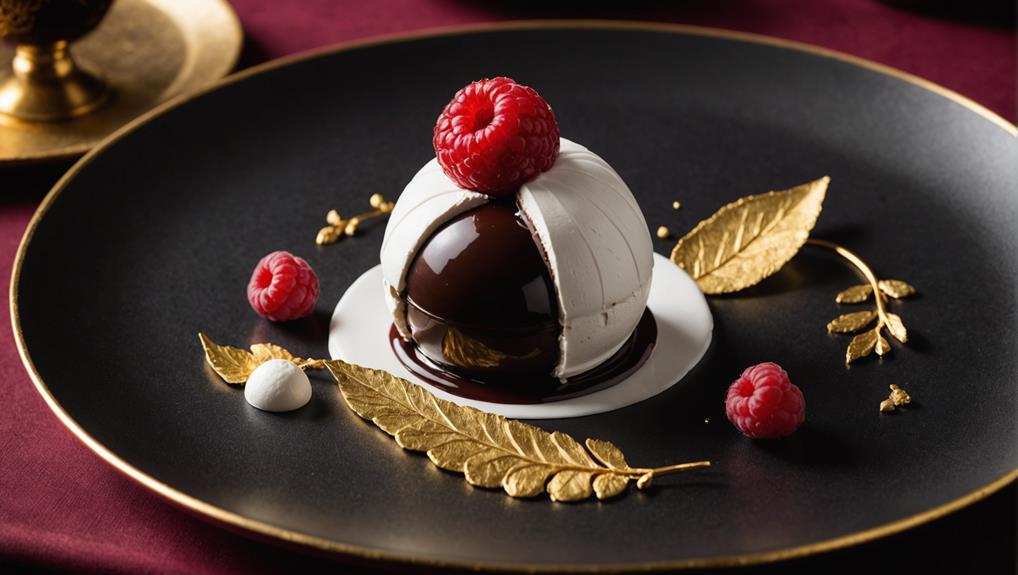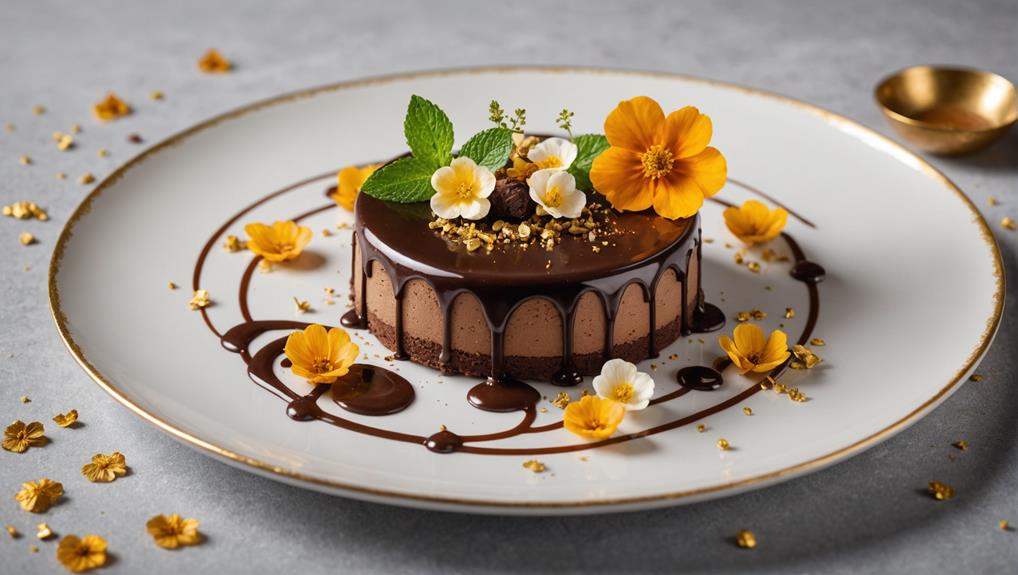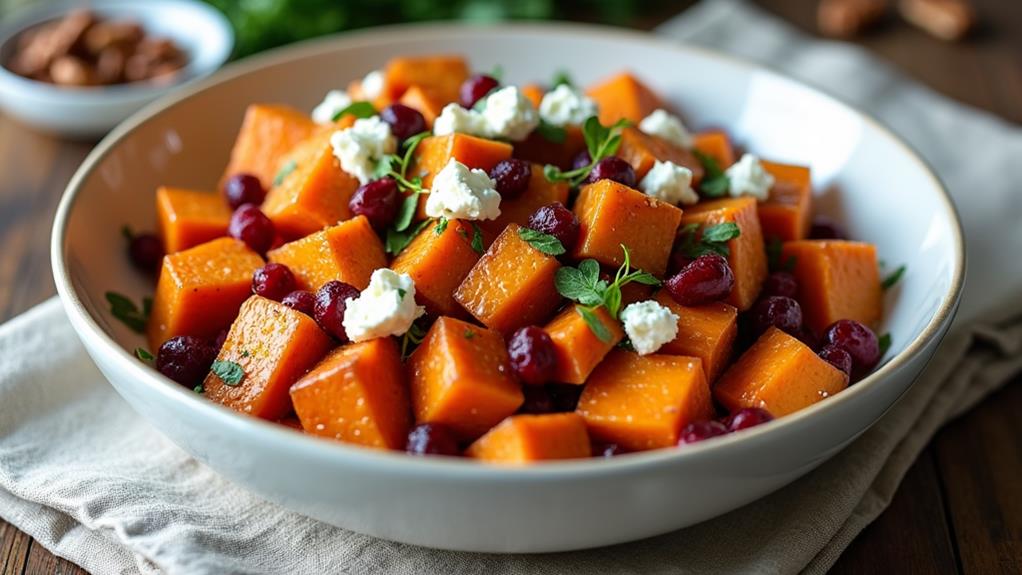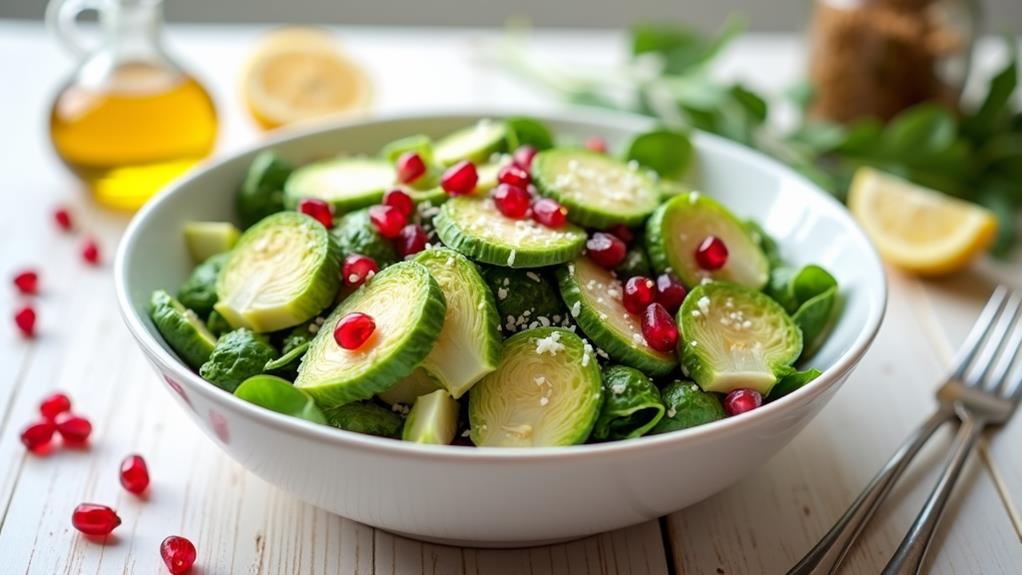Elevate your dessert artistry through the transformative power of exquisite plating. By mastering fundamental techniques, you'll create visually stunning compositions that engage all senses. Focus on color contrast, texture variation, and strategic use of negative space to enhance visual appeal. Incorporate layering and height to add depth and intrigue to your presentations. Utilize garnishes like edible flowers and chocolate sculptures to add elegance and personal flair. Balance your plate's elements, considering visual weight and cohesion. By applying these principles, you'll transform ordinary sweets into captivating culinary masterpieces that delight both the eye and palate. Explore further to unlock the full potential of your dessert creations.
Fundamentals of Dessert Plating
Several key fundamentals underpin the art of dessert plating. To elevate your dessert presentations, you'll need to master the interplay of color, texture, and visual appeal.
Start by considering the contrast between elements on the plate. Utilize vibrant hues and varying textures to create an engaging composition that captivates the eye.
Plating techniques such as careful layering and artful sauce drizzling can transform a simple dessert into a work of art. Don't overlook the power of garnishes like edible flowers or precisely piped whipped cream to add that final touch of elegance.
Attention to detail is crucial when it comes to mastering negative space. By strategically leaving areas of the plate empty, you'll create a cleaner presentation that allows each component to shine.
Experiment with different plate shapes to manipulate height and focus, guiding the diner's eye across your creation.
Mastering Composition and Balance
Building on the fundamentals of dessert plating, mastering composition and balance takes your presentation to the next level. As you strive for innovation, remember that achieving balance involves strategically distributing components across the plate. A well-crafted dish, similar to a refreshing lemon basil pasta salad, showcases how careful arrangement enhances the dining experience.
You'll want to create an even visual weight that invites the eye to explore every element of your dessert.
Embrace the power of negative space in your composition. By leaving uncluttered areas around your focal point, you'll enhance visual clarity and emphasis. This technique helps highlight your dessert's key features, making them stand out.
Don't shy away from incorporating height in your presentations. Adding vertical elements not only creates visual intrigue but also introduces layers of texture and flavor, elevating the overall dining experience.
Color contrast is crucial in creating a visually appealing plate. Use vibrant hues to enhance appetite appeal and draw attention to individual elements. This makes your dessert more inviting and enticing.
By mastering the arrangement and composition of your desserts, you'll create a cohesive presentation that's harmonious and aesthetically pleasing.
Creating Visual Contrast

How can you elevate your dessert presentation from ordinary to extraordinary? One powerful technique is creating visual contrast. By strategically employing contrasting elements in your food presentation, you'll captivate diners and stimulate their appetites before they even take a bite.
For instance, consider the beautiful layering of flavors found in Caramel Apple Cheesecake Bars. Start by pairing rich, dark desserts with bright fruit coulis to create a stunning pop of color. This visual contrast not only enhances the dish's appeal but also makes it more enticing.
Next, incorporate different textures to add depth and engage multiple senses. Combine a smooth, creamy mousse with a crunchy biscuit to create an exciting interplay of textures.
Don't forget the power of negative space. By leaving some areas of the plate empty, you'll draw attention to your dessert's key elements and create a balanced composition. Highlight specific components with decorative drizzles or vibrant garnishes to add sophistication and create focal points.
Texture in Dessert Presentation
When you're plating desserts, consider how layering different textures can create visual depth and intrigue.
You'll want to contrast smooth elements, like mousses or creams, with crunchy components, such as tuiles or brittle, to engage both the eye and the palate.
Layering for Visual Depth
Layering for Visual Depth (Texture in Dessert Presentation)
Why settle for a flat, one-dimensional dessert when you can create a visual masterpiece through layering? Layering in dessert presentation offers a powerful way to add visual depth and intrigue to your plates. By incorporating multiple textures and heights, you'll transform ordinary sweets into visually stunning plates that captivate diners before they even take a bite.
Inspired by the artisanal beauty of gingerbread cookies, which often feature rich flavors and eye-catching designs, you can elevate your dessert artistry to new heights.
To create eye-catching layered desserts, consider these key elements:
- Use clear containers or transparent plates to showcase beautiful stratification
- Vary heights to create a dynamic visual experience
- Mix textures for a range of sensory experiences
- Incorporate negative space to highlight intricate details
When you layer creamy mousses, crunchy bases, and airy elements, you're not just building a dessert; you're crafting an experience.
The contrast between smooth chocolate ganache and rough crushed cookies invites the palate on a textural journey. By thoughtfully arranging layers with varying heights, you'll draw attention to each component's unique attributes.
Contrasting Smooth and Crunchy
From silky smooth to delightfully crunchy, contrasting textures in dessert presentation create a sensory symphony on the plate. By incorporating both smooth and crunchy elements, you'll elevate your desserts from ordinary to extraordinary, engaging diners on multiple sensory levels.
This strategic approach to plating not only enhances visual appeal but also creates a multi-dimensional tasting experience that significantly boosts overall dining enjoyment.
To achieve a pleasing plate with contrasting textures, consider pairing velvety components like mousses or creams with crumbly cookies or crunchy pralines. This combination stimulates the palate and adds depth to the dessert's flavor profile.
As you layer smooth sauces or creams with crunchy elements, you'll create visual interest that invites diners to explore the different sensations each element brings to the dish. Remember, well-executed textural contrasts can lead to improved overall perception of flavor, as diners are more likely to savor and enjoy a dessert that captivates both their eyes and taste buds.
Enhancing Mouthfeel Through Presentation
Three key elements work together to enhance mouthfeel through dessert presentation: variety, layering, and strategic use of space. In the art of plating, you'll find that incorporating diverse textures elevates the dining experience, making each bite a memorable journey.
By carefully arranging creamy, crunchy, and silky components, you create a symphony of sensations that engage the palate and delight the senses.
To truly master the fine dining approach to dessert presentation, consider these techniques:
- Build vertical structures to showcase different textures
- Utilize negative space to emphasize individual elements
- Add contrasting garnishes for visual and textural interest
- Pair smooth and rough textures to enhance flavor perception
Garnish Artistry for Desserts

When you're ready to elevate your dessert presentation, consider incorporating edible flower arrangements and chocolate sculpture techniques into your garnishing repertoire.
You'll find that carefully placed edible flowers can add a touch of elegance and natural beauty to your desserts, while mastering the art of chocolate sculpting allows you to create intricate, eye-catching decorations that will impress your guests.
Edible Flower Arrangements
Countless desserts can be transformed into stunning works of art with the skillful use of edible flowers. When you're looking to elevate your plate presentation and create unforgettable dining experiences, incorporating these delicate blooms can make all the difference.
Not only do edible flowers add visual appeal, but they also introduce unique flavors and nutritional benefits to your desserts.
To make the most of edible flowers in your creations, consider these innovative approaches:
- Layer vibrant petals atop mousses or custards for a pop of color
- Sprinkle delicate blossoms across tarts or pies to create texture
- Embed whole flowers within gelatos or sorbets for a surprise element
- Arrange a variety of edible flowers to form intricate patterns or designs
Remember to source pesticide-free, safe-for-consumption flowers to ensure your diners' health and safety.
By incorporating seasonal blooms, you'll not only showcase your creativity but also highlight the freshness of your ingredients.
Edible flowers offer endless possibilities for enhancing dessert plating, allowing you to craft visually striking and flavor-packed creations that will captivate your guests' senses and leave a lasting impression.
Chocolate Sculpture Techniques
Mastering chocolate sculpture techniques can transform your desserts from ordinary to extraordinary. To create aesthetically pleasing chocolate garnishes, you'll need to temper your chocolate precisely, maintaining temperatures between 88°F and 90°F for dark chocolate. This process ensures a glossy finish and stable structure for intricate designs that'll make every dish stand out.
You can explore two main methods: molding and sculpting. Molding involves pouring melted chocolate into specific shapes, while sculpting allows you to manipulate tempered chocolate into three-dimensional forms.
Essential tools like spatulas, pastry brushes, and heat guns will help you refine your creations, achieving smooth finishes and intricate details.
For added luxury, consider applying edible gold leaf or dust to your sculptures. This enhancement not only elevates the visual appeal but also contributes to a memorable dining experience.
Transforming Plates Into Edible Canvases
Transforming plates into edible canvases elevates dessert presentation to an art form. Plating involves intricate designs that showcase a chef's creativity and skill, turning each dish into a visual masterpiece. This approach transforms simple desserts into gallery-worthy creations, captivating diners' gaze and enhancing their overall experience.
To create these edible works of art, you'll want to focus on:
- Contrasting colors for visual appeal
- Varied textures to add depth and complexity
- Negative space for artistic balance
- Unique elements to express personal style
By utilizing techniques like drizzle patterns and layer stacking, you can craft desserts that are as visually stunning as they're delicious. Incorporating bright fruits against rich chocolates or adding crispy tuilles to velvety creams not only enhances the aesthetic but also stimulates the appetite.
Don't be afraid to experiment with edible flowers, dusting powders, or artistic sauce smears. These elements allow you to express your unique style, turning each plate into a one-of-a-kind creation that delights all the senses.
Frequently Asked Questions
What Are the 5 Guidelines in Plating Dessert?
When plating desserts, focus on balance, color contrast, height, negative space, and garnishing. These plating techniques create visual harmony and enhance flavor balance. You'll transform simple sweets into innovative culinary masterpieces that delight both eyes and palate.
What Is the Most Important Factor in Creating an Exceptional Plated Dessert?
Picture a vibrant lemon tart with lavender cream. You'll find the most crucial factor in exceptional plated desserts is visual appeal. Mastering presentation techniques, color contrast, and flavor balance elevates your creation from mere food to edible art.
What Are the 5 Basic Elements of Plating?
You'll master plating with these five elements: balance, color, height, focus, and negative space. Don't forget color harmony, texture contrast, and plate selection to elevate your creations. Innovate by blending these principles in unexpected ways.
What Is the Nordic Look Technique?
Ever admired Nordic aesthetics? You'll love the Nordic Look technique. It's a minimalist presentation style that embraces nature-inspired designs. You'll create serene, elegant desserts with clean lines, natural colors, and seasonal ingredients, highlighting flavors through striking yet uncomplicated arrangements.
Final Thoughts
As you embark on your journey through the artistry of dessert plating, you're not just arranging sweets, you're painting edible masterpieces. Like a skilled artist wielding a brush, you'll transform simple plates into canvases of culinary delight. Each element you place is a brushstroke, each texture a layer of depth. Your desserts will tell stories, evoke emotions, and captivate diners' senses. With practice and creativity, you'll elevate your desserts from mere treats to unforgettable experiences, leaving lasting impressions on every palate.















